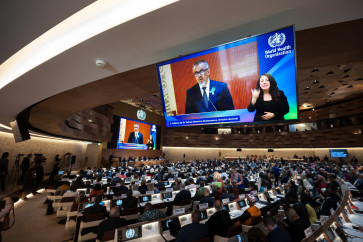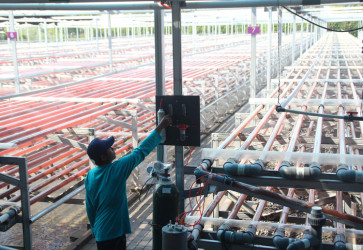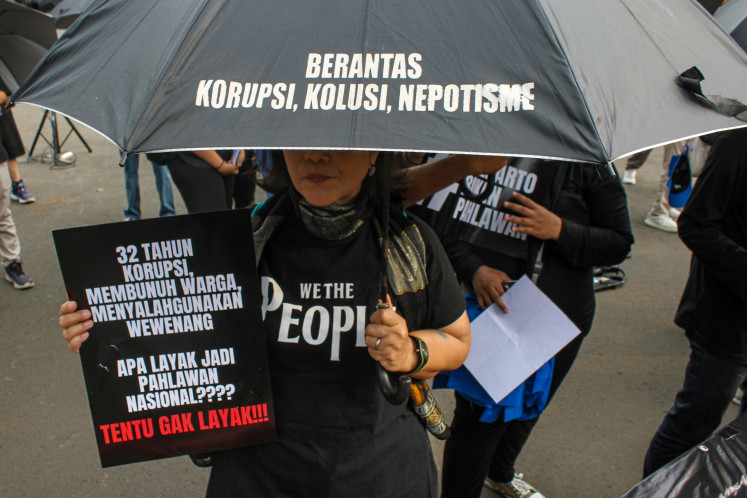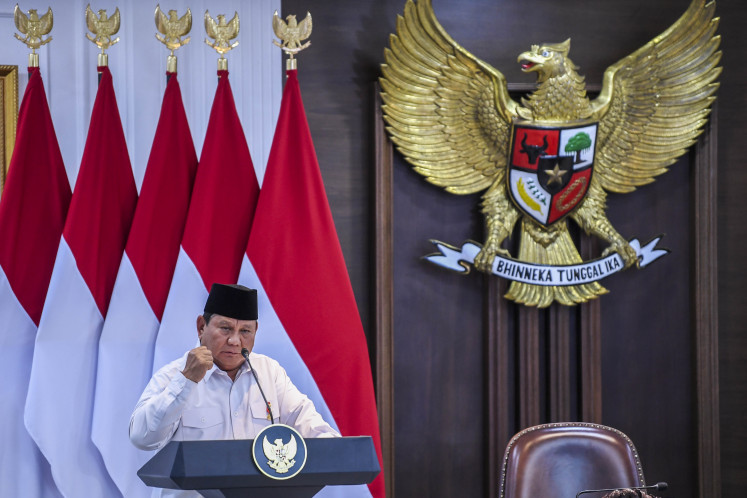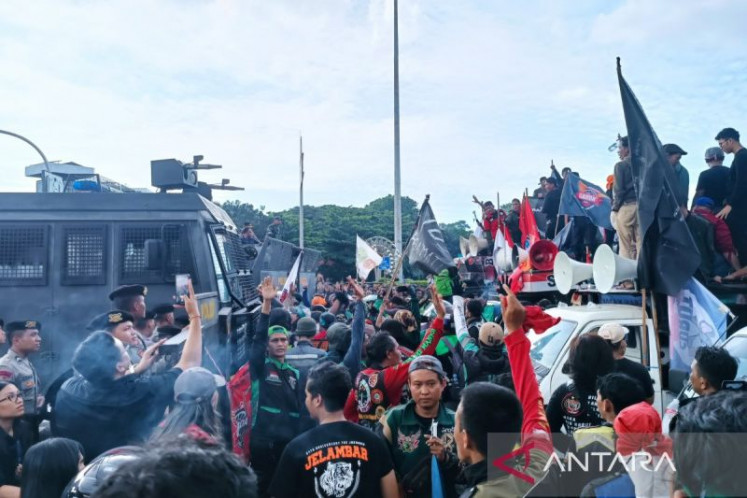[ANALYSIS] The supply chain opportunity in the race to zero
Southeast Asia is at the heart of many global supply chains, acting as a valued trade, investment and growth driver for the region. In the global race to net-zero, there is a growing need to recognize and tackle the carbon emissions burden of supply chains.
Change text size
Gift Premium Articles
to Anyone
![[ANALYSIS] The supply chain opportunity in the race to zero](https://img.jakpost.net/c/2021/02/10/2021_02_10_110482_1612929776._large.jpg)
S
outheast Asia is at the heart of many global supply chains, acting as a valued trade, investment and growth driver for the region. In the global race to net-zero, there is a growing need to recognize and tackle the carbon emissions burden of supply chains. This does not come at the price of affordable or accessible regional economic opportunities.
Recent research published by the World Economic Forum (WEF) and Boston Consulting Group (BCG) reveals how tackling supply-chain emissions can transform the global fight against climate change. Net-Zero Challenge: The Supply Chain Opportunity analyzes the top eight global supply chains, which together account for more than 50 percent of global greenhouse gas (GHG) emissions. The report shows that end-to-end decarbonization of these supply chains would add as little as 1 percent to 4 percent to end-consumer costs in the medium term by introducing key levers that can be easily and affordably deployed today.
Embracing responsible supply chains is a lucrative proposition, with studies revealing more than 50 percent of consumers in Western markets will pay more for sustainable products. This sentiment is echoed in many mature markets, with demand for sustainably marketed products growing seven times faster than contemporary counterparts over the last five years. Failing to address supply chain emissions may soon position Indonesia at a disadvantage in global trade.
Our changing world
2021 is a year which hints at hope. It marks the delayed 2021 United Nations Climate Change Conference (COP26) — a vital crossroads in our shared emissions mitigation efforts.
The world’s commitment to defeat the COVID-19 pandemic has illuminated the remarkable actions we can take to overcome adversity. As we look toward the potential impact of a 2-degrees-Celsius global warming pathway, it is clear action at a deeper and wider scale is needed now.
We have seen momentum grow in 2020. The United Kingdom and the European Union are committed to net-zero by 2050. South Korea and Japan both recently committed to net-zero emissions by 2050. China — the world’s largest GHG emitter — has committed to net-zero emissions no later than 2060. With United States President Joe Biden’s pledge to achieve net-zero by 2050, trade partners accounting for half of ASEAN’s total trade value will soon have established net-zero targets.
2020 also accelerated existing supply-chain shifts, as COVID-19 highlighted the risks of single-supplier business models. The resulting disruption, combined with escalating costs in major manufacturing markets like China, has seen expanding manufacturing interest in Southeast Asia. This reveals the growing importance of the region to a truly decarbonized supply chain.
The role of customer-facing companies is particularly important in this transition. Tackling company supply chains will reduce emissions by a magnitude far greater than direct operational impacts. Nestlé’s direct operations account for just 5 percent of its total emissions, for example. Supply chain mitigation is a critical pathway to reduce end-to-end GHG emissions with limited additional costs.
A pathway to greener supply chains
Eight supply chains — food, construction, fast-moving consumer goods (FMCG), electronics, automotive, professional services, fashion, and freight — account for more than half of global GHG emissions. Southeast Asia represents a significant participant in global supply chains for all eight.
Analysis shows that China, the EU and the US together account for almost three-quarters of Southeast Asia’s global CO2 export flows. The evidence reveals mature and maturing markets are increasingly outsourcing their carbon burden to production hubs such as Southeast Asia.
Indonesia’s own role in these areas is substantial. Agribusiness was one of Indonesia’s largest export sectors in 2019, worth more than US$22 billion. Indonesia is also a major exporter of metals, mining products and chemicals, which together contributed more than $55 billion to exports. These are key supply chain elements for construction, electronics and the automobile industry. The nation’s role in the global fashion supply chain is also significant, with fashion and luxury exports valued at $18 billion. More than 80 percent of end-product emissions for customer-facing companies in construction, food, automotive and fashion, and 77 percent in electronics, is attributable to supply-chain emissions, known as Scope 3 emissions.
Analysis shows that approximately 40 percent of all emissions in these supply chains could be abated with readily available and affordable levers at a cost of just $10 per ton of CO2 equivalent, using mechanisms such as circularity and increased use of recycled materials, material and process efficiency improvements and increased adoption of renewable power and heat. Interventions that reduced supply-chain emissions to zero would result in just 1 percent to 4 percent increase in end-consumer costs in the medium term.
While the interventions are broadly accessible, the reality remains that decarbonizing supply chains is challenging. Even the most experienced companies struggle to access and act upon the right data, particularly in fragmented supply-chain landscapes. That can be a challenge in certain sectors in Indonesia, such as smallholders in agribusinesses or fashion’s extensive informal and micro-enterprise worker base.
Land use for agriculture and deforestation contribute the largest share of emissions for food, an industry accounting for roughly a quarter of all GHG emissions. Nature-based solutions that promote more sustainable and deforestation-free agriculture is a valuable opportunity for Indonesia, with moves in this direction already underway.
Companies looking to tackle end-to-end emissions must recognize and adopt the right measures to reduce supply-chain impacts. The WEF-BCG Net-Zero Challenge report sets out nine major actions CEOs can address:
1. Build a comprehensive emissions baseline, gradually filed with actual supplier data
2. Set ambitious and holistic reduction targets, and publicly report progress
3. Revisit product design choices for sustainability
4. Design a sustainable value chain and geographic sourcing strategy
5. Set and track ambitious procurement standards
6. Work jointly with suppliers to address their emissions
7. Engage in sector-specific initiatives with peers to maximize impact and level the playing field
8. Leverage scale through ‘buying groups’ to lower the cost of green solutions
9. Develop internal governance mechanisms to align the incentives of decision-makers with emission targets
Companies that act have the opportunity to drive significant positive change, not only in their own supply-chain emissions, but across the landscape.
Working with suppliers across Southeast Asia to address emissions will be a vital part of this regional journey for many companies, ensuring that customer-facing businesses can cushion the cost of interventions for low-margin industries in a region where pricing concerns will be a major factor in the direction of travel.
Supply-chain decarbonization will be a game-changer for the impact of corporate climate action. Addressing supply-chain emissions is fundamental for companies to realize credible climate change commitments.
Now is the time to act and deliver the supply-chain emission reductions Indonesia, Southeast Asia and the world needs.
---------
Dave Sivaprasad is managing director & partner, SEA leader for climate action, Boston Consulting Group and Eddie Martono is partner, Boston Consulting Group

